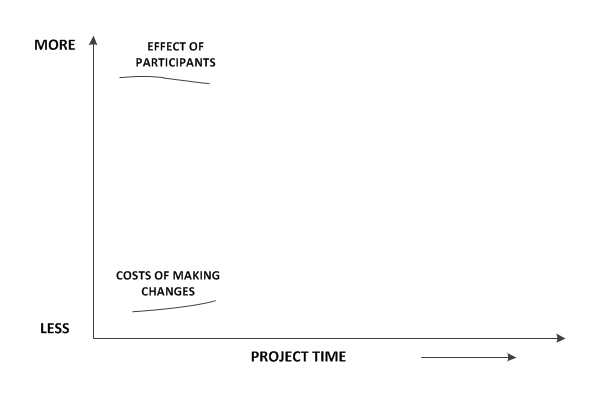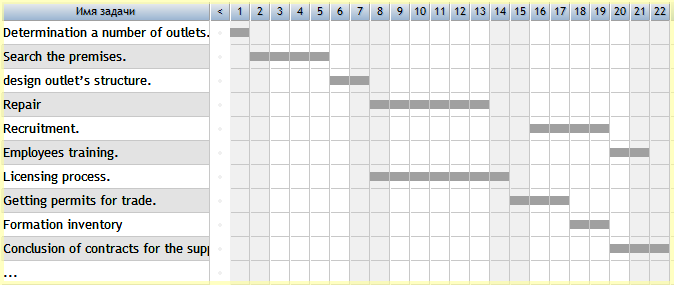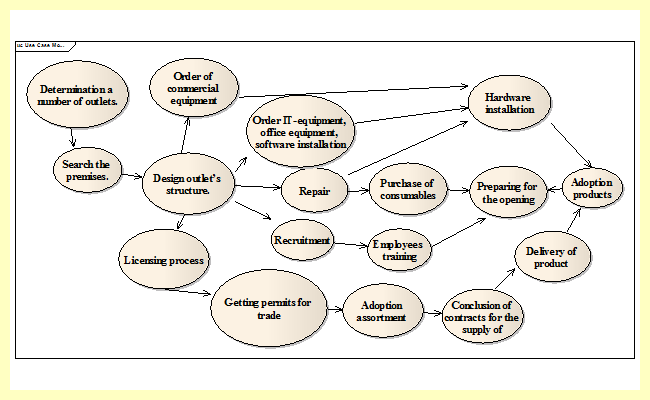Abstract
Content
- Introduction
- 1. Theme urgency
- 2. Review of existing systems
- 3. Description of the object of research
- 4. The purpose and tasks of the Master's work
- 5. Defining a list of works in the project
- 6. Review of the methods of network planning
- 7. Review of intelligent optimization methods
- Conclusion
- References
Introduction
Currently, the project is the idea and the actions for its implementation to create a product, service or other useful result. The implementation of the project is a complex of measures, works and activities aimed at achieving the objectives of the project. The project and the process of its implementation is a complex system in which the project itself acts as the controlling subsystem. The management of project is a control subsystem. The project is characterized by:
- certain purpose;
- certain resources (human, material and financial resources);
- certain execution time;
- uniqueness [1].
The main functions of project management in the international standard PMBoK [3] are the nine functions of project management, one of these functions is management of time of the project. It is most important, because performs the scheduling of works for the project. Management of time of the project, includes processes which ensure timely completion of the project:
- definition of operations Ц the process of definition operations which must be performed for obtaining of the results of the project;
- determining the sequence of operations Ц the process of identifying and documenting the dependence between the operations in the project;
- resources evaluation of operations Ц the process of evaluation types and quantities of materials, human resources, equipment or deliveries required for each operation;
- estimate durations Ц the process of determining the number of work periods required to complete certain operations with expected resources;
- Schedule development Ц the process of analyzing sequences of operations, their duration, resources and time restriction to create the project schedule.
One of the important trends in project management at the present time is to research the possibility of introduction the computerization of the distribution of resources in the project, which help to achieve the most efficient performance of his work.
1. Theme urgency
Project management, as a sphere of practice, successfully developed over the years. Beginning of using project management related to the increase in the scale of projects that had to fit in a certain time and on budget. Right planning of the project can save resources of the company (financial, human, material resources and time). [2] In practice, people often use simple planning methods, when, for example, a list of works prepared with their due dates without good optimization. But, this planning is permissible only in small routine tasks, when planning a large size of works itТs necessary to use appropriate methods and tools to promptly and accurately plan the due dates of the individual fragments of the project.
One of the important trends in project management at the present time is to research the possibility of introduction the systems of computerization of the distribution of resources of the project, which would achieve the most efficient performance of his work.
In the chart below we can see how the costs are increasing by making changes in the project during time, and the ability of participants to make changes to the project.

Figure 1 Ц Ability to make changes in the project in time
(animation: 7 frames, 25 cycles of repeating, 96,3 kilobytes)
We can conclude that the more accurate will be planned the project, the more resources will be saved.
2. Review of existing systems
We analyzed the existing project management systems, such as Microsoft Project, Easy Projects.NET, OpenProj.
Microsoft Project (or MSP) is designed to assist project managers in developing plans, allocating resources to tasks, tracking progress and analyzing workload. Microsoft Project creates a critical path schedule. Schedules can consider the resources which used. The chain is visualized in a Gantt chart. [4] This program is the most popular project management system[11].
Easy Projects. NET Ц a web based project management application software development, written on .NET by Logic Software. Among the features of this application are present:
- Project Management (available to users the Gantt chart, graphs and reports)
- task management and bug tracking
- management of the time and resources
- budget management
- integration (export to MS Project)[12].
OpenProj Ц a crossЦplatform software for project management. Free commercial product. Available for operating systems Microsoft Windows, Linux, Unix, Mac OS.
OpenProj features comparable to Microsoft Project 2007 Standard Edition. There is the possibility of graphical reports (Gantt charts, network diagrams, charts, resource scheduling problems). There is the ability to filter, sort and grouping tasks. Implemented the ability to import and export from /to Microsoft Project. There is the possibility of creating reports[13].
The researching of these software products, showed that they are not suitable for this task. This is due to several factors. Many systems do not use optimization methods and methods of reduce the time of the project. Require a significant change in the application to a specific problem. Require maintenance. Have a high price. In this system I want to realize a detailed breakdown of time resources, it is will save time of development and implementation of the project.
3 Description of the object of research
The object of research is the process of allocation projectТs resources. The content of the project is to open a new retail outlet in accordance with the planned timing of their commissioning. The company has a task in the calendar year to implement the opening of a fixed number of outlets. The leadership sets the task to project team: Outlets have to begin to work in a given period of time and have to use available resources optimally
.
4. The purpose and tasks of the Master's work
The purpose of the master's work is development a tool that would automate the scheduling of operations that make up the project with the effect of the restriction and the use of modern mathematical methods. This tool can be a computerized decision support system for the planning and management of this project.
If we want to create a conceived system of project management, we have to perform the following tasks:
- Identify methods for the graphical representation of the project implementation plan
- Identify methods for the detailed allocation of resources in the project
- Study literature by project management
- View existing systems
- implement the learned methods in a software project
5. Defining a list of works in the project
First of all, we have been researched and analyzed the work that make up the project in question (according to the Management of the time of project
). Here is a list of works:
- Determination a number of outlets.
- Search the premises.
- design outletТs structure.
- Repair.
- Recruitment.
- Employees training.
- Licensing process.
- Getting permits for trade.
- Formation inventory
- Adoption assortment
- Conclusion of contracts for the supply of
- Delivery of product (when the point is ready)
- Adoption products (only possible after paragraph 12)
- Order of commercial equipment
- Order ITЦequipment, office equipment, software installation.
- Hardware installation.
- Purchase of consumables (such as buckets, hoe, etc.)
The works can also be serial and parallel. If all works are serial, the allocation of resources wouldnТt be big deal, but with the advent of parallel works raises the question: Where to direct resources in the first place, what work?
. That is necessary to analyze the connectivity of the works and the availability of shared resources for their implementation.
To solve these problems people use the methods of network planning that allow you to analyze the beginning and ending of unrealized parts of the project, and to link the implementation of various works and processes in time, the forecast total duration of the entire project. Network planning have some methods that have been researched.
6. Review of the methods of network planning
The simplest and most obvious method is the method of drawing up a Gantt chart related to linear methods. Gantt chart Ц a popular type of bar chart that is used to illustrate the plan, timeline for any project and is one of the methods of planning projects. Gantt consists of strips oriented along the time axis. Each bar on the chart represents a separate task in the project, it ends Ц the beginning and completion of the work, its length Ц the duration of the work.
Gantt chart is not, strictly speaking, the work schedule (with one shift work does not shift all the rest). And this is one of its main weaknesses. In addition, the Gantt chart does not reflect the importance of resource or work does not show the nature of work (scope). For large projects, the Gantt chart is too heavyЦhanded and loses all visibility. [5] As we can see in Figure 2, these shortcomings are the place to be. So imagine how hard it is to work with such an enlarged diagram of 10Ц100.

Figure 2 Ц Gantt chart
Network schedules are based on another mathematical models Ц a graph and have a few options.
Critical path method Critical Path Method (CPM). This method is represented as a graph in which the works are shown as arrows, and the dependencies between them as nodes. At the arrow is typically the name of the work, and under the arrow corresponding to the time of its execution. The first node is called the initial event, the second Ц the final event. Nodes are assigned a serial number. The method relies on the definition of the longest sequence of tasks from the beginning to the end of the project in view of their relationship. The tasks that lie on the critical path (critical tasks) have a zero reserve runЦtime, and, in the event of a change in their duration, change timing of the project. In this regard, during the project critical tasks require more careful monitoring, in particular, the timely detection of problems and risks affecting the terms of their performance and, therefore, the timing of the project as a whole. In the course of the project's critical path of the project may change as a change task durations, some of them may be on the critical path.
Essence of the solution of the problem to reduce the network schedule is reduced to provide additional resources to perform work on the critical path, removing works that do not lie on the critical path, paralleling the work [6].
MetraЦPotentialЦMethod (MRM) is characterized in that the works are displayed nodes and their relationships Ц with arrows. Node give you all the information regarding the operation, and the arrows show the dependencies Ц previous and subsequent work. In the node that displays the work placed its serial number, the name and duration. Also may be placed short texts e.g. indicating contractors. Further, along with the duration of work specified, and free reserves of time, as well as early and late times of the beginning and end of the work. Figure 3 shown the use of MRMЦmethod in this task

Figure 3 Ц MPMЦmethod
Method PERT Ц Program Evaluation and Review Technique. PERT method implements a probabilistic approach to determining the duration of the work, using the mean value Distribution. The method uses three estimates of timing for each operation:
- Optimistic (the best)
- expected (probabilistic)
- pessimistic (worst)
Network matrix. Effective tool in the management of the project are the soЦcalled network matrices which represent a higher level of scientific development of the traditional network graphs. Network matrix is a graphical representation of the process of the project, where all the work (administrative and operational) are shown in a particular processing sequence and the necessary relationships and dependencies. Network matrix is aligned with the calendar and the time scale grid. The rows indicate the level of management, organization department, or officer performing a particular job; columns Ц the stage and the separate operations of the project management process, occurring over time.
Main advantage of network planning is a visual representation of the interdependence works. Furthermore, they include the timing and calculation of the critical path. It is a valuable tool for planning and project management. On the other hand, network planning technique makes high demands on employees that make up the network plan. The network plan is only useful when it is made qualitatively. Since the development of the plan requires detailed information about all the jobs, we need more training to its development. After the first pass, when normally calculated expiry date of the project is beyond the scope of contractual terms, there is a need to optimize the network plan. Often estimated completion date of the project so far beyond the scope of contractual terms that have hard to explore different reserves. Therefore, even though the network plan and contains very important information for the management of the project, its preparation and support is not always the appropriate means to manage the project.
7. Review of intelligent optimization methods
Certain way out of this impasse is the use of modern software based on the use of intelligent optimization techniques in the computerized subsystem supports the decision. For a detailed allocation of resources in the project, you can use genetic algorithms or ant.
Genetic algorithms Ц a heuristic search algorithm is used to solve optimization problems and modeling by random selection, combination and variation of the desired parameters using the mechanisms resembling biological evolution.
Ant Algorithms Ц one of the most effective polynomial algorithms for finding approximate solutions of the route finding on graphs. The approach is to analyze and use behavior of ants looking for ways of the colony to the source of power and is a metaheuristic optimization.
Conclusions
In this work identified a list and a relationship of works. We analyzed existing systems which used for network planning. Here were analyzing the using methods of network planning for project management, justified the using of intelligent methods of optimizing the allocation of work and the development of computer system.
In writing this abstract master's work is not yet complete. Final completion: winter 2013Ц2014. The full text of the work and materials on the topic can be obtained from the author or his head after that date.
References
- ƒульзон A.A. ”правление проектами: учебное пособие/ј.ј. ƒульзон; Ќациональный исследовательский “омский политехнический университет.Ц3Це изд., перераб. и доп.ЦToмск: »здЦво “омского политехнического университета, 2010.Ц334с.: ил.
- ѕинто ƒж. . ”правление проектами/ѕерев. с англ. под ред. ¬.Ќ.‘унтова Ц —ѕб: ѕитер, 2004 Ц 464с. : ил. Ц (—ери€ Ђ“еори€ и практика менеджментаї).
- A guide to the project management body of knowledge (PMBoK Guide) /Project Management Institute. Ц3ded. ЦTown Square, 2004.
- »спользование Microsoft Project 2002. —пециальное издание. : ѕер. с англ. Ц ћ. : »здательский дом Ђ¬иль€мсї, 2003. Ц 1184с. : ил. Ц ѕарал. тит. англ.
- Jesse Russell ƒиаграмма √анта Ц ISBN 978Ц5Ц5128Ц6250Ц6; 2012 г.
- ’илл ѕ. Ќаука и искусство проектировани€. ћетоды проектировани€ и научное обоснование решений. ћ.: Ђћирї, 1973, 264 с.
- Koza J.R. Genetic Programming.Cambridge:MA:MIT Press,1992.
- Ѕатищев ƒ.». √енетические алгоритмы решени€ экстремальных задач..¬оронеж: ¬оронежский технический ун≥верситетюЦ1995.Ц65с.
- E.Alba, J.M.Troya.. A survey of parallel distributed genetic algorithms//Complexity,vol.4,no.4,pp.31Ц52,1999.
- G. Harik, F. G. Lobo, D. E. Goldberg. The Compact Genetic Algorithm. //IEEE Trans. Evolutionary Computation. Ц 1999. Ц vol. 3.Ц pp. 287Ц297.
- The Free Encyclopedia «Wikipedia» Ц Microsoft Project: http://ru.wikipedia.org/wiki/Microsoft_Project
- The Free Encyclopedia «Wikipedia» Ц Easy Projects .NET: http://ru.wikipedia.org/wiki/Easy_Projects_.NET
- The Free Encyclopedia «Wikipedia» Ц OpenProj: http://ru.wikipedia.org/wiki/OpenProj
